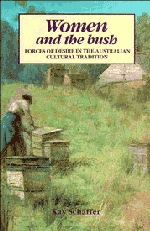Book contents
- Frontmatter
- Contents
- ACKNOWLEDGEMENTS
- INTRODUCTION
- Dedication
- CHAPTER 1 CULTURE, LANGUAGE AND THE SELF
- CHAPTER 2 IN SEARCH OF A NATIONAL IDENTITY
- CHAPTER 3 THE BUSH AND WOMEN
- CHAPTER 4 LANDSCAPE REPRESENTATION AND NATIONAL IDENTITY
- CHAPTER 5 HENRY LAWSON: THE PEOPLE'S POET
- CHAPTER 6 BARBARA BAYNTON: A DISSIDENT VOICE FROM THE BUSH
- CHAPTER 7 CONCLUSION
- NOTES
- BIBLIOGRAPHY
- INDEX
CHAPTER 4 - LANDSCAPE REPRESENTATION AND NATIONAL IDENTITY
Published online by Cambridge University Press: 10 January 2011
- Frontmatter
- Contents
- ACKNOWLEDGEMENTS
- INTRODUCTION
- Dedication
- CHAPTER 1 CULTURE, LANGUAGE AND THE SELF
- CHAPTER 2 IN SEARCH OF A NATIONAL IDENTITY
- CHAPTER 3 THE BUSH AND WOMEN
- CHAPTER 4 LANDSCAPE REPRESENTATION AND NATIONAL IDENTITY
- CHAPTER 5 HENRY LAWSON: THE PEOPLE'S POET
- CHAPTER 6 BARBARA BAYNTON: A DISSIDENT VOICE FROM THE BUSH
- CHAPTER 7 CONCLUSION
- NOTES
- BIBLIOGRAPHY
- INDEX
Summary
Many nations have adventured for the discovery of Australia, but the British peoples alone have possessed her.
Sir Keith Hancock, AustraliaWoman is never anything more than the scene of more or less rival exchange between two men, even when they are competing for the possession of mother-earth.
Luce Irigaray, ‘This Sex Which is not One’This chapter brings together and expands some of the concerns traced in Chapter Two: In Search of a National Identity and Chapter Three: The Bush and Women. It is primarily about landscape representation. But the territory it explores is at once physical and linguistic, sexual and social, literal and figurative. A historical question I want to address is: how is it that the land known as Terra Australis Incognita came to be named, tamed and, in Hancock's words, possessed by British interests—initially on behalf of Empire and eventually on behalf of Australian native sons? On another level the question becomes one about identity. How has man as subject confronted this land as alien other and attempted to define himself through his attempts to understand his origins in the land; to come to terms with his experience of its space and boundaries; to assimilate its strangeness into himself and his symbolic order? These are the processes through which people who came to live on the land and fill in what Hancock called its ‘vast, open spaces’ have constructed their images of identity as Australians.
- Type
- Chapter
- Information
- Women and the BushForces of Desire in the Australian Cultural Tradition, pp. 77 - 111Publisher: Cambridge University PressPrint publication year: 1989



